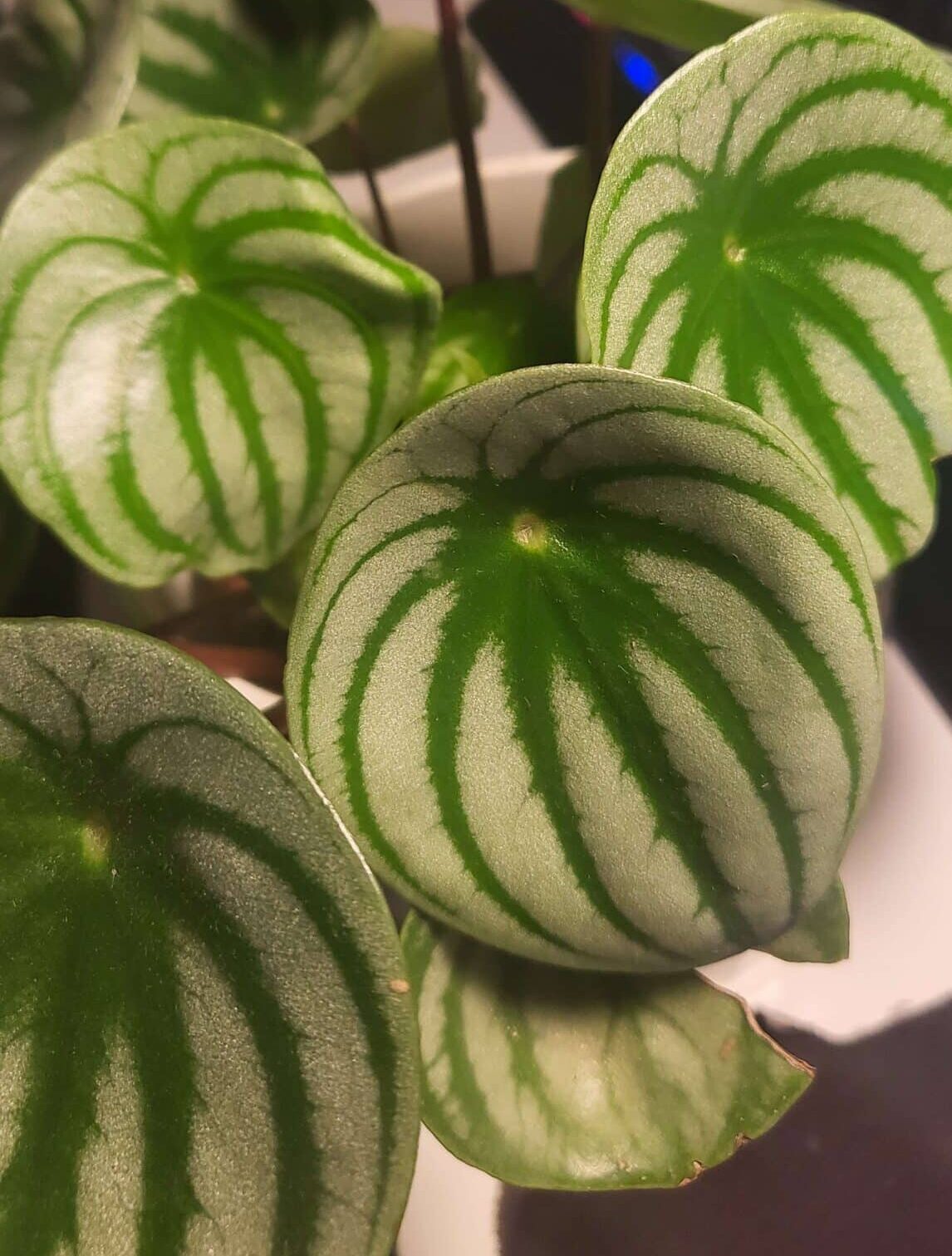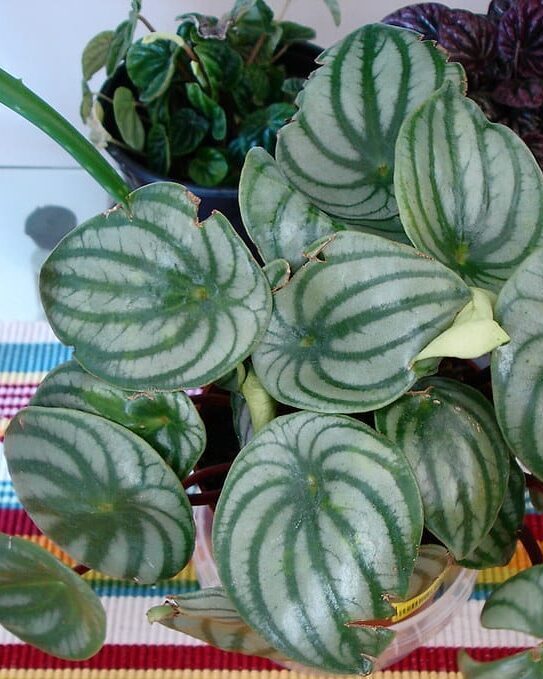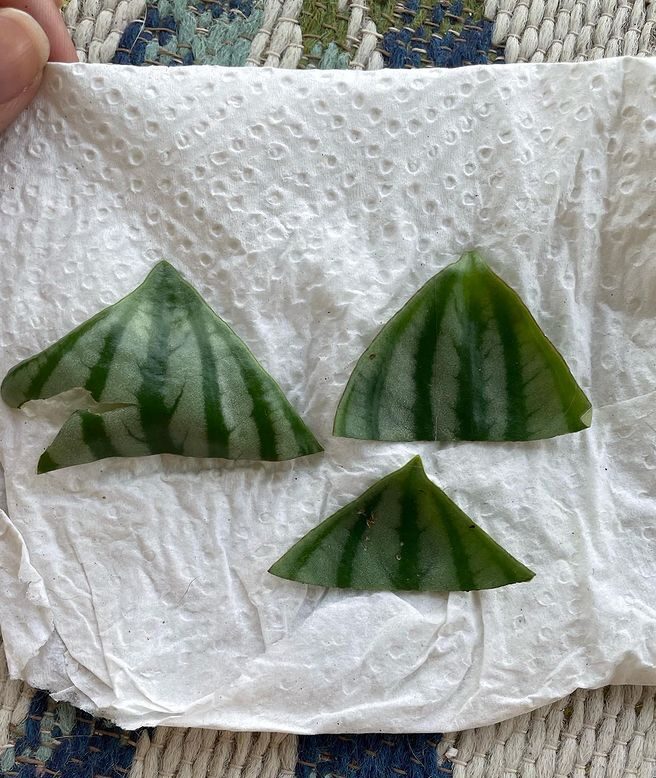Do you know that Large Watermelon Peperomia got its name for the perfect replication of watermelon?
Interestingly, their care demand remains the same as traditional, easy-care routine despite its growing world fame.
So, continue reading to discover how to grow Large Watermelon Peperomia to its maximum potential.
Table of Contents Show
Overview of Large Watermelon Peperomia
Large Watermelon Peperomia is a perennial tropical plant with stunning green leaves complemented by silver streaks.
It has gained fame over the past years for its shimmering looks and easy care routine. Moreover, they fit excellently in indoor conditions.

This plant is the best choice for those whose plant parenting journey has just begun.
So, let’s begin with a brief overview of Large Watermelon Peperomia.
| Indicator | Identity |
|---|---|
| Scientific Name | Peperomia argyreia |
| Common Name | Watermelon Peperomia |
| Native Area | Brazil, Venezuela, Ecuador, Bolivia |
| Family | Piperaceae |
| Flowering | Tiny green flowers blooming in a cluster |
| Flowering Season | During growing season of spring and summer |
| Grown For | Evergreen foliage with dramatic silver strips |
| Growth Size | Up to 12 inches tall and 8 inches wide |
| Growth Speed | Slow to moderate growth |
| Growth Type | Erect and bushy |
| Container | Glazed or plastic pot |
| Growth Zone | Zones 10-12 |
| Plant Type | Perennial |
| Availability | Commonly available |
| Toxicity | Non-Toxic to pets and humans |
Did you know Large Watermelon Peperomia is popular with watermelon begonia name?
However, Watermelon Peperomia is not a begonia plant at all.
Where to Buy Large Watermelon Peperomia?
I am certain you have seen people showing off their beautiful Watermelon Peperomia plant all over their socials.
If you also want to flaunt its beauty at your place, I have mentioned some online stores below for you to buy one.
| Site | Shipping Details |
|---|---|
| Green Door Garden | Within 1-3 days |
| Garden Goods Direct | Within 1-5 business days |
| Bloomscape | Within 2-7 Days |
Large Watermelon Peperomia: Ultimate Grow & Care Guide
Large Watermelon Peperomia has been shining bright in almost every household adding a glamorous natural touch.
Even though this plant is considered an easy-to-care plant, it still needs some care.
All you have to do is recreate its natural home, so they feel homely and grow without a problem.
Here is brief information about their natural and preferred environment parameters.
 At least 5-6 hours of indirect bright sunlight |  Once a week in spring and summer Once in three weeks in fall and winter |
 Well-draining, light sandy mix pH level: 6 to 6.6 |  Balanced 10-10-10 fertilizer once a month during the growing season |
 Around 70°F(21°C) |  High humidity levels (>50%) |
 After 2-3 years in spring or early summer |  Propagate Division and leaf cuttings |
1. Sunlight & Temperature
Most indoor plants thrive best when kept in an indirect sunlit place, and your Watermelon Peperomia is one of them.
However, when exposed to inadequate sunlight, the plant shows signs like leggy, dull, and stunted growth.
The ideal place for your plant is north or east-facing windows with sheer curtains.

On top of that, dry, crispy, and curled leaves are the signs of excessive sunlight.
As most of the light is received through the south-facing window, you can place your plant about 4-5 feet away from it.
Meanwhile, you must ensure your plant receives bright sunlight for at least 5-6 hours.
Tips to Maintain Proper Lighting & Temperature
- Ensure to provide 2-3 hours of morning sunlight to your Large Watermelon Peperomia.
- If you plan to grow them outdoors, ensure you place them under a partial shade.
- Even in artificial grow lights, it thrives well so you may use a full-spectrum LED light. Use grow lights for up to 10-12 hours during winter or fall as a substitute for natural sunlight.
- If you live in a place where the temperature drops below 50°F, try using a heating pad underneath the pot to keep them warm.
2. Watering & Humidity
Large Watermelon Peperomia is native to South America and thrives well in warmer temperatures.
Moreover, water your Large Watermelon Peperomia plant once a week after the topmost soil layer gets dry during active growth and reduces watering during winter.
Typically, you will notice leaves curling, drooping, and overall plant wilting down due to insufficient watering and low humidity.
Also, when humidity exceeds 70%, it increases the potential risk of fungal disease to the plant.
Tips to Maintain Ideal Watering and Humidity
- Gather around the plant together to promote humidity.
- During summer, mist the plant leaves to keep the humidity in check.
- Install artificial room humidifier to adjust humidity level as per requirement.
- Use a moisture meter to measure the moisture of soil to water accordingly.
- Rainwater or distilled water best fits the needs of Large Watermelon Peperomia.
3. Soil & Fertilization
Even if Large Watermelon Peperomia does not demand special soil, they still expect well-draining soil to flourish.
In addition, adding perlite and coco coir to sand will make an excellent potting mix for Watermelon Peperomia.
As compact soil does not facilitate excess water drainage, ensure you do not use such soil for Watermelon Peperomia.
When they are not getting enough nutrients, it tends to droop, limp, and cause prolonged growth. So, if you notice such signs, fertilize your plant right away.
Tips to Maintain Proper Soil & Fertilization
- When choosing synthetic fertilizers, try finding liquid fertilizers rich in Nitrogen and Potassium.
- When using liquid fertilizers, dilute them to their half strength and apply them without direct contact with the plant.
- You can use natural organic fertilizers like compost, manure tea, egg shells, and vermiculite.
- Some commercial soil recommendations are Miracle-gro Potting Mix and Espoma Potting Mix.
4. Occasional Pruning
Large Watermelon Peperomia elevates interior decors with tear-dropped shape foliage with silvery-white stripes.
And it does not need routine pruning to justify its easy-to-grow nature.
Before the active growth season starts, you should consider pruning leggy stems to promote vigorous growth.
Additionally, pruning any infected leaves or parts as soon as you notice them will end further spreading.
The major pests & pathogens infecting the plant are Mealybugs, Spider mites, Scale & Mycosphaerella brassicicola.
Tips to Prune Large Watermelon Peperomia
- Inspect and remove any infected leaves or parts.
- Use sterilized sharp pruners or scissors for clear cuts by holding them at a 45° angle.
- Do not go overboard with pruning; prune only 30% at a time.
- Wipe the plant’s leaves occasionally to ensure a shiny dustless look.
- Use masks and gloves when pruning plants.
- After pruning, thoroughly water the plant to reduce repotting stress.
- Try using organic solutions such as spraying your plant with Neem oil and horticultural oil.
5. Frequent Repotting
Large Watermelon Peperomia is a slow-growing plant that will enchant you from the same spot for years.
You can replace the topsoil once a year between the complete repotting duration.
Ensure you choose one size bigger pot compared to the previous one when repotting.
They show some tell-tale signs when they require repotting. They are;
- Roots are coming out from drainage holes.
- Soil no longer holds moisture.
- The plant stopped growing even in the active growing season.
- It has been more than three years since the last repotting.
Remember repotting means a lot of stress for your plant, so keep repotting frequency minimum.
Steps to Repot Large Watermelon Peperomia
- Prepare Tools and Potting Mix
- Early Spring or Summer is the best time to repot your plant.
- Take out the plant from the container.
- Transplant into the new pot.
Growth Rate, Foliage, and Flowering
Generally, Large Watermelon Peperomia grows about 12 inches tall with 8 inches wide when provided with proper care.
This counterpart of the plant goes through dormancy during the winter season. So, cut back on watering and fertilization during this time.

They are famous for their stunning waxy green foliage and dramatic silvery-white stripes. They also have a flaunting maroon-reddish slim stem to support their bushy appearance.
The red stems are thin and non-woody, and the leaves feel fleshy to the touch.
Moreover, Large Watermelon Peperomia blooms look like green and brown spikes and need almost 4-6 years.
After getting mature, Watermelon Peperomia bloom in summer, but they rarely bloom indoors.
Once they reach maturity, they are likely to bloom every year, each with a life span of nearly two weeks.
Additionally, they do produce seeds as well, but they are not easy to extract.
But many plant owners do not let blossoming to preserve plants focus on their foliage growth.
Toxicity of Large Watermelon Peperomia
If we look at the popular indoor plants, they are not all pet-friendly and have darker sides.
But, Large Watermelon Peperomia has only brighter sides making it an ultimate choice as an indoor plant.
According to ASPCA, Watermelon Peperomia is non-toxic to your furry dogs and curious cats.
What a friendly, glamorous, alluring plant Watermelon Peperomia is, right?

However, be cautious, as your pets might try to chew the plant. If your pets accidentally eat a lot of this plant, they might experience a mild stomach upset.
Secure the plant when kept at certain heights, as it may cause unpleasant events.
Keeping the plants safely out of your pets’ and kids’ reach is always a good idea.
Propagating Large Watermelon Peperomia
You have multiple methods available to propagate your Watermelon Peperomia.
But stem cutting is preferred more as it is easy and more effective.
1. Propagating via Stem Cutting
Summer or spring would be the best time to propagate the plant via stem cutting.
Let’s get started with a step-by-step guide.
- Ensure you trim the stem from the base, leaving a 2-3 inches long stem.
- Fill a transparent jar with distilled water and add a few drops of liquid rooting hormones.
- Submerge the cutting in the water, but leave the leaf out.
- Replace the water every 2 or 3 days and provide favorable conditions.
2. Propagation via Leaf Cuttings
Large Watermelon Peperomia can also be propagated via leaf cutting but usually takes longer than stem cutting.
Here’s a stepwise guideline.
- Find a healthy green leaf and cut them with at least an inch or more long stem.
- Cut the leaf symmetrically to get equal halves. You shall now have one half with an attached stem.
- Make sure you cut the leave in one clean slash.

- Prepare a pot with fresh potting mix and ensure they are moistened before placing cuttings.
- Put the stemless half of the leaf into the soil while ensuring the cut edge is buried properly.
- Plant the stem in the potting mix while leaving its leaf above the surface.
- Wait for one or two months, and new growths shall be noticeable. Let them be for a few more months, then transplant them into individual pots.
3. Propagation via Division
Another way of propagating Watermelon Peperomia is via root division.
Let’s get started.
- It is efficient to perform division during repotting, so wait till repotting time.
- Take out the plant tenderly from the pot and remove excess soil.
- Identify offshoots and, with great care, separate them from the plant.
- Plant them in a separate pot, followed by a thorough watering.
- Make sure you place them where it is subtly warm and receives bright indirect light.
- Also, keep the soil moist during the first few weeks, then continue the usual watering routine.
Large Watermelon Peperomia Vs. Lookalike Plants
Other indoor plants share a similar resemblance with your large Watermelon Peperomia plant.
Even though they share some similarities, they also have distinct features that help us distinguish one another.
Let’s explore those similarities and differences.
| Varieties | Similarities | Differences |
|---|---|---|
| Pilea | Broad, flat green leaves Both features a peltate leaf structure | Leaves do not have dramatic pattern whereas Peperomia have silver stripes. |
| Peperomia Frost | Both share wide leaves with pointed tip and 2-3 lobes. Both have small flowers resembling white or pink spikes. | Have thicker, more upright foliage but Large Watermelon Peperomia have thinner, more trailing leaves. |
| Mini Watermelon Peperomia | Both features watermelon skin lookalike foliage. Both belong to Piperaceae plant family. | Mini grows up to 6 inches tall but large reaches up to 12 inches. Mini has less round, more pointy leaves. Mini has smaller lengths stems whereas large have much longer stems |
From Editorial Team
Conclusion!
Large Watermelon Peperomia is a tropical semi-succulent plant gaining fame over time for its gorgeous green foliage along silver strips.
Their lower maintenance and requirement needs to make them ideal for beginners and professional plant parents.
All you need to do is ensure proper watering, sufficient indirect sunlight, and ideal humidity.
Happy Plant Parenting!!


